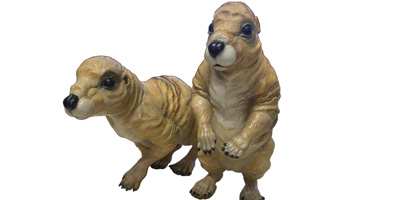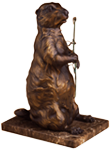M HOUSE Prairie Project 2025

Santa Fe is a small city with a lot of sculpture lining the streets. That was a huge part of why I moved here from Southern California. What I also discovered lining the streets of Santa Fe, were the prairie dogs. Santa Fe in 1998 had numerous prairie dog colonies that coexisted daily with us noisy messy humans.
Seeing them reminded me of possums; Southern California has a lot of them. They too stayed in the shared urban environment, regardless of a city growing up around them. I thought they were either courageously resourceful, or just too stubborn to leave. Maybe a little of both. I would often see possums at night in my back yard with babies on their backs, scavenging for food from trash cans. Possums have two primary strategies to survive. The first to play dead, the second to look the most fearsome of all animals. Two strategies that urban human animals can more than relate to.
Prairie dogs use a different strategy to survive near constant danger. Digging extensive tunnels called burrows, they can hide and protect themselves all year. When danger is detected, the alert is sounded in short nasal-like yips by prairie dogs, like my sculpture "Ranger Mack", that keep a vigilant watch. When the danger is passed, another prairie dog will come out and jump-yip that it's safe. Unlike the possums I grew up with, the prairie dogs were much more connected to community and group survival.
I felt myself beginning to adapt my own strategies for survival back in high school. Without knowing it I was using the prairie dog strategy of finding a safe burrow; only poking my head out for classes. I could not navigate the lunch time quad social scene. I was awkward. I never knew what to say, or how to look. I spent my freshman year in the library, my safe burrow. When I eventually found the ceramic room was open during lunch, I spent the next three years there. Truly I was moving only from burrow to burrow.
Leaving home and going to college became a bigger challenge. I used the possum's strategy of 'Playing Dead" as my next survival move. Trying to project an air of "I'm nothing to worry about, no problems here", in the hopes of adapting a kind of invisibility. I also used the rat's strategy; scurrying from concealment to concealment, trying to keep the other humans from seeing me at all. For people who were harder to evade, I adapted the possum's other strategy of looking ferocious. Fortunately, in time I was able to make new friends, and found my place of comfort in the Sculpture Department.
Moving and living in Santa Fe was encouraging both for me as an artist, and for my curiosity about prairie dogs and other urban animals.
One place I used to visit often after moving to Santa Fe was a wonderful pottery store called "Jack A Lope". There they had a prairie dog "pit", a kind of habitat built connected to the store. I took a lot of pictures. You could feed the prairie dogs carrots, which people did. In time I came to realize that prairie dogs are not that fat in the wild. Regardless, these photos became the beginning of what I would call the "Prairie Dog Project".
At that time, I lived in a studio and worked for stone sculptor Mark Harris. I also had other sculpture projects, outside of my prairie dogs. A larger-than-life pregnant hyena was one. It was an unusual sculpture in that it had exaggerated features which made it a deviation from my usual style. I was also working on a quarter life-size fountain piece called "The Happy Tiger".
Around the time the first two "Prairie Dog Project" pieces were cast in bronze, I decided to become a personal trainer. My attention to detail in sculpture paid off in this new venture. I was able to take the focus I used in creating art, and apply it to working with people who had difficult physical challenges. I was happy to see how one skill informed the other, and in time, how the personal training began to inform new detail in my sculptural work. When COVID struck, I retired from personal training and began creating even more Prairie Dogs.
I wanted to create unique prairie dog individuals in their real-life poses. I had two complete, but I knew I would need a lot more. I wanted people to see these animals as little beings they could relate to. My vision for the project was to create a prairie dog coterie, (a colony), that would be placed in the local public Plaza. People may or may not notice them at first, but when they do, I hope there's surprise and wonder. Perhaps these sculptures may move people to take a moment out of their day to appreciate these astounding creatures.
People like myself who grew up in cities, have difficulty observing wild animals without either humanizing them, of thinking of them as just cute pets. There are few opportunities for the average person to watch wild animals and learn respect for them. As animals go extinct, people who are removed from nature can live without seeming to feel the effect. Why care much about creatures in the far-off jungle or ocean? Here in Santa Fe, prairie dogs are our neighbors. They have survived as the city grows around them. Unfortunately, many are now landlocked and unable to move their burrows to fresh grass. These city dogs now die prematurely from starvation, poisoning and limited habitat.
A year ago, I found a pamphlet that stunned me. Its title was "Prairie Dogs: The Most Important Animal in New Mexico". Prairie dogs are a "Keystone Species", which means besides the desert environment itself, the survival of seven other species depend on them. I had no idea the extent of this animal's importance. The information in the pamphlet got me thinking about what I can do to help, using my twelve bronze prairie dog sculptures. Starting the "Prairie Project" was primarily about liking and admiring creatures that live right here in our town, besides being just so damn cute! But now the question became more about impacting the community to help and really see these animals and all they do for us.
I asked myself, what does this have to do with art? I'm not a wildlife activist, but working on this project for so many years has made me more observant of prairie dog coteries in Santa Fe. Prairie dogs have been slowly disappearing. Now, with so many new construction projects on hand, that process is accelerating. Sometimes overnight large colonies have been bulldozed over. Santa Fe and Albuquerque have ordinances that protect prairie dogs from harassment and mandate they be relocated. Unfortunately, these laws are not regularly enforced and are given little attention.
I want to use the adorable charm these animals have to bring enjoyment and educate people. I want people to see little beings in my work. That's why I named them. It's harder to harass and exterminate an animal you relate to. Perhaps animal art is a step to recognize the value in all creatures. A way to pull human focus back to nature and all it does for us without us even noticing.
The "Prairie Dog Project" began for me 20 years ago. In some ways it feels like the journey is truly starting now. I believe time will tell where it all ends up.
